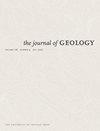评估古土壤的风化和钾变质作用程度:以劳伦大陆中部元古代、寒武纪和白垩纪古土壤为例
IF 1.3
4区 地球科学
Q2 GEOLOGY
引用次数: 0
摘要
详细研究了劳伦大陆中部苏必利尔湖地区的六元古代、两个寒武纪和两个白垩纪古土壤。除白垩纪古土壤外,所有古土壤都经历了钾交代作用,导致元古代古土壤中白云母或寒武纪古土壤中伊利石和微斜长石的沉淀。通过深度归一化质量通量(DNMF)对古土壤中钾交代作用的大小进行比较,其中DNMF=1000×[(质量通量)/(风化深度)],对不同厚度的风化剖面进行归一化。总添加K2O的平均DNMF值,元古代古土壤为0.98±0.19 mol cm−3,寒武纪古土壤为1.27±0.06 mol cm–3。通过元古代McGrath、Ville-Marie和Baraboo古土壤中交代白云母的40Ar/39Ar同位素测年,确定了钾交代作用的年龄,得出的年龄分别为1742±3、1589±3和1467±11Ma,前者与Yavapai造山运动同期,后者与Baraboo造山运动同步。寒武系Trempeleaau古土壤中的变体微斜长石产生了488.0±1.0Ma的高原年龄,对应于寒武系-奥陶系边界的年龄。SiO2、CaO和Na2O通过风化从古土壤中基本上被去除,K2O也是如此(交代作用之前)。六种元古代古土壤对SiO2、CaO、Na2O和K2O的平均去除总量为17.6%±1.9%,两种寒武纪古土壤为28.5%±4.2%,两种白垩纪古土壤为36.5%±8.6%,五种现代土壤为34.2%±2.7%。尽管显生宙大气中的二氧化碳含量较低,但与元古代相比,显生宙风化剖面中的风化程度更大,这可能反映了约500 Ma时陆地植物的出现及其对风化的深刻影响。本文章由计算机程序翻译,如有差异,请以英文原文为准。
Evaluating the Magnitudes of Weathering and Potassium Metasomatism in Paleosols: Examples from Proterozoic, Cambrian, and Cretaceous Paleosols in Midcontinental Laurentia
Six Proterozoic, two Cambrian, and two Cretaceous paleosols in the Lake Superior region of midcontinental Laurentia were investigated in detail. All but the Cretaceous paleosols experienced potassium metasomatism, which resulted in the precipitation of muscovite in Proterozoic paleosols or illite and microcline in Cambrian paleosols. A comparison of the magnitude of potassium metasomatism among the paleosols is provided by depth-normalized mass flux (DNMF), where DNMF=1000×[(mass flux)/(depth of weathering)], which normalizes for different thicknesses of weathering profiles. Average DNMF values for the total addition of K2O are 0.98 ± 0.19 mol cm−3 for the Proterozoic paleosols and 1.27 ± 0.06 mol cm−3 for the Cambrian paleosols. The ages of potassium metasomatism were determined by 40Ar/39Ar isotopic dating of metasomatic muscovite in the Proterozoic McGrath, Ville Marie, and Baraboo paleosols, which yielded ages of 1742 ± 3, 1589 ± 3, and 1467 ± 11 Ma, respectively, the former being coeval with the Yavapai orogeny and the latter with the Baraboo orogeny. Metasomatic microcline in the Cambrian Trempealeau paleosol yielded a plateau age of 488.0 ± 1.0 Ma, which corresponds to the age of the Cambrian-Ordovician boundary. SiO2, CaO, and Na2O were substantially removed from the paleosols by weathering, as was K2O (before metasomatism). The average total amount of SiO2, CaO, Na2O, and K2O removed was 17.6% ± 1.9% from six Proterozoic paleosols, 28.5% ± 4.2% from two Cambrian paleosols, 36.5% ± 8.6% from two Cretaceous paleosols, and 34.2% ± 2.7% from five modern soils. The greater magnitude of weathering in the Phanerozoic weathering profiles compared with the Proterozoic ones, despite lower levels of CO2 in the Phanerozoic atmosphere, may reflect the emergence of land plants at ∼500 Ma and their profound effects on weathering.
求助全文
通过发布文献求助,成功后即可免费获取论文全文。
去求助
来源期刊

Journal of Geology
地学-地质学
CiteScore
3.50
自引率
5.60%
发文量
0
审稿时长
3 months
期刊介绍:
One of the oldest journals in geology, The Journal of Geology has since 1893 promoted the systematic philosophical and fundamental study of geology.
The Journal publishes original research across a broad range of subfields in geology, including geophysics, geochemistry, sedimentology, geomorphology, petrology, plate tectonics, volcanology, structural geology, mineralogy, and planetary sciences. Many of its articles have wide appeal for geologists, present research of topical relevance, and offer new geological insights through the application of innovative approaches and methods.
 求助内容:
求助内容: 应助结果提醒方式:
应助结果提醒方式:


